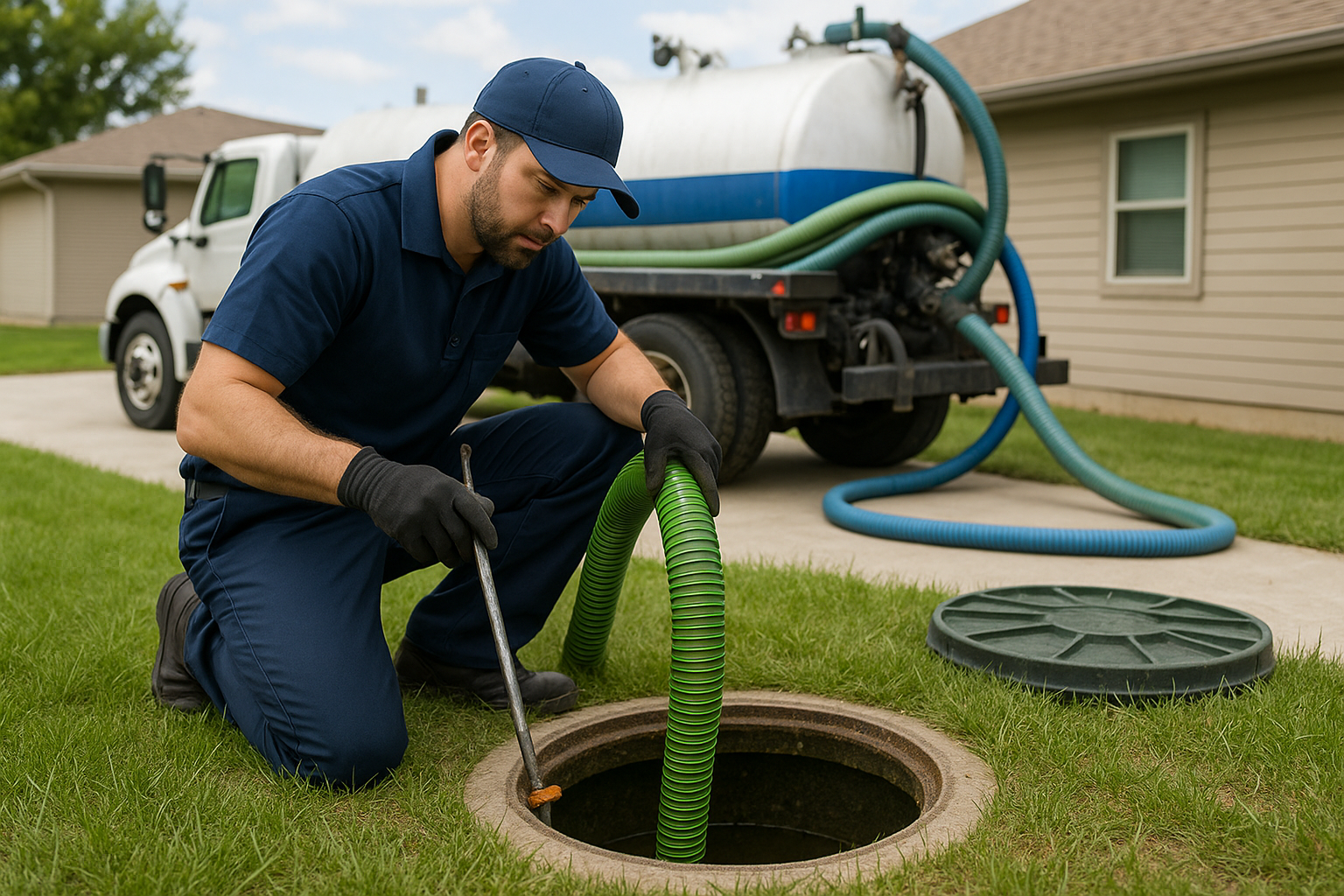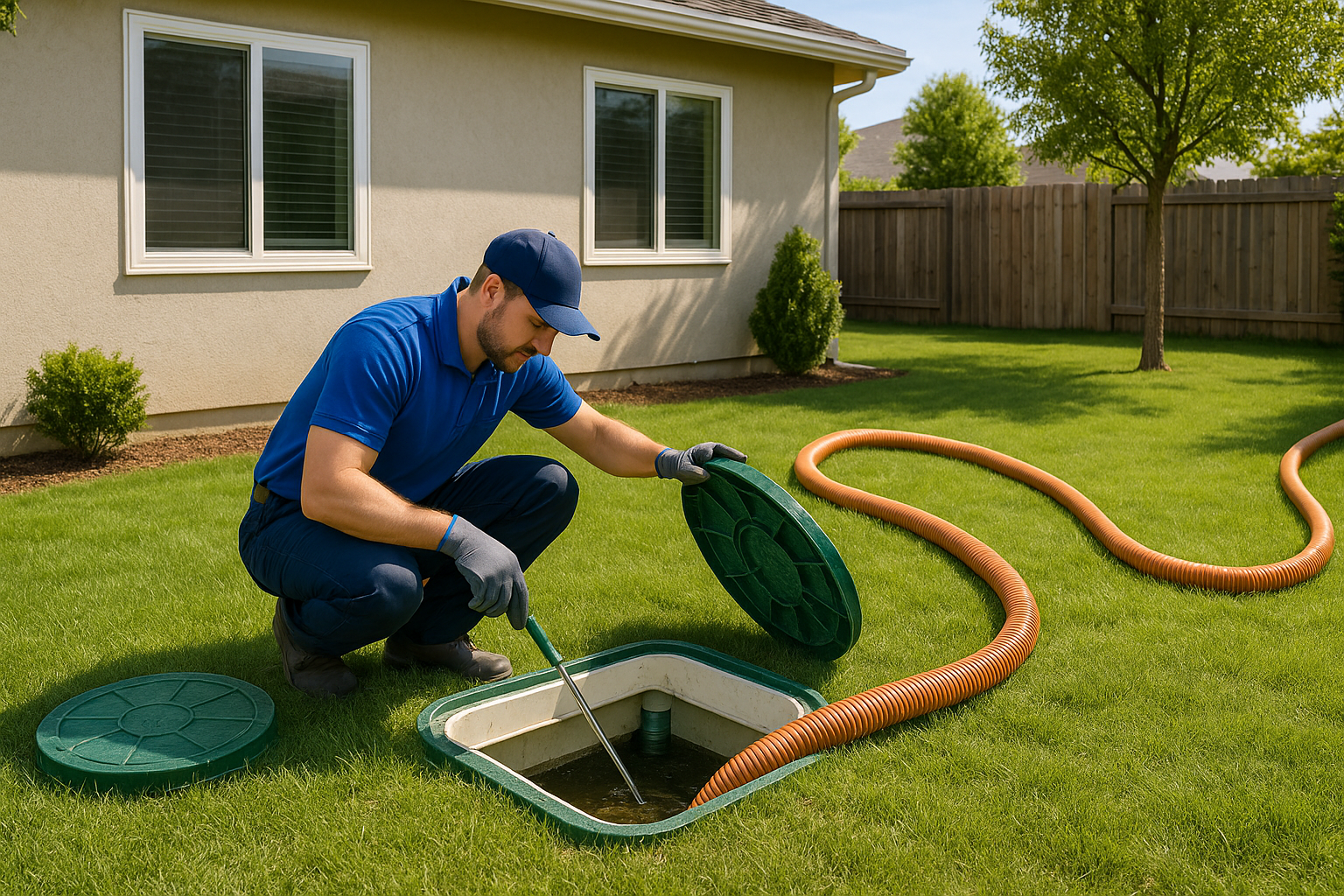If you own a septic system, your real work happens underground, where septic tank bacteria do the heavy lifting. These tiny helpers digest solids, reduce odors, and keep effluent flowing to the drainfield. When the balance is right, your system is quiet and trouble-free. When the balance is wrong, you get slow drains, smells, or surprise backups.
This guide turns microbiology into plain steps any homeowner can follow. You will see how septic system bacteria live, what hurts them, and the smartest ways to support them with pumping, habits, and only the right septic treatments when they add value.
There are different types of bacteria involved in septic tank function, each with varying effectiveness in breaking down waste and maintaining system health. Blue Ribbon Septic serves households across the region with transparent pricing and tidy work, and this playbook reflects what we teach customers in the field every week.
Introduction to Septic Tanks
What a septic tank does
- Underground tank for homes not on municipal sewer lines; handles all household wastewater (toilets, sinks, laundry).
- Inside the tank, anaerobic digestion by beneficial septic tank bacteria breaks down solid waste and organic matter into liquid and gases.
- A sludge layer forms at the bottom over time and must be pumped out as part of normal septic tank maintenance to prevent clogging and system failure.
Why maintenance matters
- A healthy septic system depends on regular maintenance and the right septic tank treatment to keep bacteria populations thriving.
- If sludge isn’t removed, buildup can block the system, causing costly repairs and unpleasant surprises.
How to keep it trouble-free
- Understand how your septic tank works and stick to a routine of inspections, pumping, and care to keep the system healthy, efficient, and trouble-free for several years.
What Is Septic Tank Bacteria?
Septic tank bacteria are naturally occurring microbes that break down solids in the tank so liquids can move to the drainfield. Support them by pumping on schedule, limiting harsh chemicals, spacing laundry, and choosing proven septic treatments when needed. Additives that promise miracles rarely replace routine maintenance.
Why Septic Tank Bacteria Matter
A healthy bacterial community digests waste, limits sludge growth, and protects your drainfield capacity. Poor bacterial activity leads to heavy scum, floating solids, and overworked leach lines. The leach field is where aerobic bacteria help further treat wastewater, improving overall system performance. Good care also protects wells and groundwater in many communities that rely on onsite systems.
How Bacteria Break Down Waste
- In the tank, anaerobic microbes consume organic solids, including organic waste, and release gases.
- Clarified liquid exits to the soil, where aerobic bacteria, which require oxygen, finish polishing the wastewater.
- Stable sludge still builds over time, which is why pumping stays essential even when biology is strong. A properly designed and maintained system reduces pathogens reaching waterways for decades.
When Bacteria Struggle And What You’ll Notice
- Frequent bleach or solvent use. These substances can harm the natural bacteria in your tank, reducing their ability to break down waste.
- Large, back-to-back laundry loads that flood the tank.
- Flushable wipes and FOGs (fats, oils, grease).
Watch out: Early signs include gurgling drains, slow sinks, and persistent odors near the tank or field, which can be early signs of a developing clog due to bacterial imbalance. If you see wet patches over the drainfield, call Blue Ribbon Septic immediately.
How To Increase Bacteria In A Septic Tank Naturally
You do not need a chemistry degree to help your microbes thrive. Follow these steps and use products thoughtfully.
Step-By-Step: Daily And Weekly Habits
- Space water use. Run laundry over several days and fix leaky fixtures.
- Avoid harsh chemicals. Choose septic-safe cleaners in small amounts.
- Keep wipes out. Even “flushable” labels cause trouble.
- Scrape plates. Limit fats and starches reaching the tank.
- Book routine pumping. Use this guide on septic pumping frequency to plan the right interval.
- Document service. Keep photos and notes from each visit.
- Pro tip: Add a riser and lid upgrade for clean, quick access during service.
Some homeowners use yeast as a natural way to support bacterial activity in their septic tanks. Yeast can help break down solid waste and produce enzymes, which aid in waste decomposition. Adding additional bacteria is sometimes recommended after events that disrupt the tank's balance, such as after using antibiotics or harsh chemicals, but this should be done cautiously and never as a substitute for regular inspections and maintenance.
Monthly And Seasonal Maintenance Checklist
- 5-minute visual check: Walk the yard and sniff for odors.
- Inspect scum layer: Check the septic tank's scum layer and ensure it is not getting too close to the outlet. Schedule pumping if needed to prevent system failure.
- Test drains: If sinks slow, note the date.
- Plan your pump-out: Read septic tank bacteria treatments for timing factors like household size and tank volume.
- Before holidays: Stage a preventive visit. Booking early avoids rush fees.
- Before rainy seasons: Confirm the downspouts route water away from the field.
The Dangers of Harsh Chemicals
Core point: Harsh cleaners and antibacterial products harm the beneficial bacteria your septic system needs leading to clogs, backups, and odors.
What causes problems
- Strong cleaning products, disinfectants, and some laundry products
- Antibacterial soaps
- Non-biodegradable items (e.g., baby wipes) flushed.
What happens
- Healthy bacteria are killed off → waste doesn’t break down.
- The system becomes less effective → higher risk of blockages.
- Chemicals can seep into soil, contaminate groundwater, and pose health risks.
How to protect your system
- Choose septic-safe cleaning products.
- Avoid flushing anything but toilet paper.
- Schedule regular maintenance to catch issues early.
- Keep septic tank bacteria healthy for a long-lasting, odor-free system.
Additives, Enzymes, Or “Do Nothing”?
Some homeowners reach for a quick fix. The use of additional bacteria and septic tank treatments is common, but their effectiveness depends on the specific situation and the current balance of bacteria in the system. Some treatments claim to rid the tank of problems, but they should be used with caution, as improper use can disrupt the bacterial balance. Only appropriate materials should be introduced to the septic system; unsuitable materials, such as plastics or non-biodegradable items, can harm the system and interfere with healthy bacteria. Here is a practical framework that blends science, field experience, and cost control.
Septic Bacteria vs Enzymes vs Chemical Additives
- Septic bacteria products can seed or support biology after disinfectant shocks or long vacancies, but results vary.
- Septic tank enzymes break down fats and starches, yet do not replace the living community. See Blue Ribbon Septic’s guide to septic tank bacteria enzymes for pros and cons.
- Chemical additives that promise “no pumping needed” often overstate benefits and can push solids into the field. Many land-grant resources note that routine pumping and sound habits outperform miracle cures.
What Is The Best Septic Tank Treatment
The “best” choice depends on your problem. Start with diagnostics and proven care.
- If odors spike or you have heavy disinfectant use, review septic tank treatments to prevent backups.
- If you want a cleaner, calmer service day, use septic tank cleaning tips and this hands-on septic tank cleaning guide.
- If solids are high, schedule a professional septic tank pumping service.
- Pro tip: Ask Blue Ribbon Septic for photo documentation of scum and sludge so you can see progress over time.
The Importance of Water Efficiency
Water efficiency is vital for a healthy septic system too much water at once can overwhelm the tank, push solids into the drain field, and cause clogs, system failure, and expensive repairs.
Why it matters
- Conserving water keeps the septic tank working properly.
- Prevents solids from escaping into the drain field.
Simple steps
- Fix leaks promptly.
- Install low-flow toilets and showerheads.
- Spread out laundry loads throughout the week.
- Use water-efficient appliances (dishwashers, washing machines).
Outcome
- Extends the life of your septic tank and drain field.
- Maintains a healthy, efficient system that’s less likely to develop costly clogs or require emergency repairs.
Common Myths And Mistakes To Avoid
- “Additives replace pumping.” No product replaces pumping. Pump on schedule to remove non-digestible sludge.
- “Chlorine kills only the bad stuff.” Disinfectants reduce overall microbial activity. Use sparingly and avoid shock doses.
- “Garbage disposals are fine.” Food solids speed sludge growth and increase pumping frequency. Improper use of a garbage disposal can overwhelm septic bacteria and disrupt the system's balance.
- “More water flushes the tank.” High flows stir solids and risk pushing them to the field.
- “All treatments are the same.” Bacteria, enzymes, and chemicals do different jobs. Match the tool to the task.
- “Wells are too deep to be affected.” Poor siting or failing systems can impact shallow wells and groundwater. Locate and maintain systems correctly.
Proof And Trust: Why Homeowners Choose Blue Ribbon Septic
- Transparent service. Technicians document every step and explain what they find.
- Not commission-based. You get recommendations you can trust.
- Local experience. Hundreds of tanks are serviced yearly across our region.
- One team for everything. Pumping, inspections, riser installs, and treatment advice. Learn more on our Blue Ribbon Septic page.
- Pro tip: Ask for a recurring reminder based on your tank size and household water use.
Keep Septic Tank Bacteria Happy And Your Home Protected
Healthy septic tank bacteria save you money and headaches. With pumping on time, sensible water use, and smart product choices, you protect your drainfield and extend system life. Start with small daily habits, add a seasonal check, and partner with a crew that shows its work. Blue Ribbon Septic will help you plan the right rhythm, choose the right septic treatments, and avoid surprise costs.






